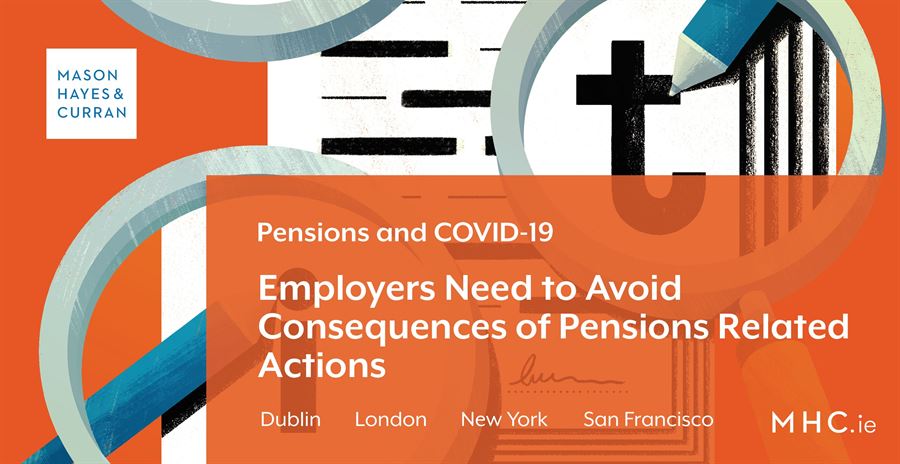
The ongoing COVID-19 crisis has resulted in a sharp rise in the number of people signing on for unemployment assistance. This has been triggered either because of redundancy or temporary lay-offs in instances where employers have been forced to significantly scale back operations in line with Government imposed physical distancing guidelines. We review the discernible bearing this is having on pensionable service and member benefits.
Temporary absence: defined benefit and defined contribution schemes
.jpg) Provisions for temporary absence for both defined benefit (DB) schemes and defined contribution (DC) schemes will, in general, be set out in the rules of the scheme. These provisions facilitate an employee who is temporarily absent from employment in remaining a member of the pension scheme during a period of absence. Though temporary absence will be defined differently in each case, broadly speaking, it would be typical for a similar definition to include:
Provisions for temporary absence for both defined benefit (DB) schemes and defined contribution (DC) schemes will, in general, be set out in the rules of the scheme. These provisions facilitate an employee who is temporarily absent from employment in remaining a member of the pension scheme during a period of absence. Though temporary absence will be defined differently in each case, broadly speaking, it would be typical for a similar definition to include:
-
A period of absence from the member’s normal occupation with the employer due to injury or illness not exceeding a specified term - two and a half years would not be uncommon
-
A period during which a member ceases to be actively engaged in his/her normal occupation with the employer where they are engaged in other work of national importance for the State
-
A period of full time education or training connected with the member’s employment, including secondment to another employer, and
-
Any other temporary break in employment with the employer for reasons other than those set out above for a specified period
Temporary absence provisions will not be triggered where an employee has been made redundant. This is because their employment is at an end and they are no longer eligible for active membership of the employer’s pension scheme. However, those that have been temporarily laid-off are likely to be classified as temporary absentees under the scheme’s rules.
In general, scheme rules will provide employers with discretion to classify members as temporary absentees. The following will be of particular relevance to an employer in these circumstances:
-
The continuance or suspension of member contributions
-
For DB schemes, the impact on member benefits where there is a break in pensionable service
Employers must tread carefully and seek legal advice where uncertainties around temporary absences arise. In some cases the temporary absence provisions in the scheme rules will require member consent before they can be treated as a temporary absentee. It will also be necessary to understand scheme provisions that relate to risk benefits and death during a period of temporary absence.
Defined benefit schemes and pensionable service
Employers that operate DB schemes should have a clear understanding of what constitutes pensionable service in their scheme. The discretions that are available to employers to permit the continuance of pensionable service for temporary absentees will need to be established, as any gap in service could dramatically impact member benefits at retirement.
Temporary lay-off and pensionable service
Where an employee is on temporary lay-off due to the pandemic, they may be entitled to the COVID-19 Pandemic Unemployment Payment. However, this social welfare payment cannot be utilised to make member contributions to a pension scheme. Employees that are laid-off may be classed as temporary absentees by their employer, but it is likely that the member’s continuous pensionable service will be interrupted unless the employer acknowledges that pensionable service will continue for the lay-off period. This may require amendment to the scheme documentation.
Pensionable service where the employer qualifies for the Temporary Wage Subsidy
Where an employer qualifies for the Temporary Wage Subsidy, Revenue has confirmed that member contributions may not be deducted for those employees in receipt of it. In these circumstances, pensionable service may also be interrupted unless the employer can acknowledge that pensionable service is to continue during the period where member contributions are suspended.
In circumstances where the Wage Subsidy can be topped up, it may be possible for an employer to allow members make a reduced pension contribution, during the period in which the employee is in receipt of the Wage Subsidy. In every case, the trust deed and rules should be checked to ensure that the employer has the necessary discretion to permit a reduction in member contributions. It would also be prudent for employers to obtain advice on all employment law aspects before proceeding.
Conclusion
The COVID-19 pandemic will continue to create issues for employers for some time to come. Employers that have laid-off staff will inevitably focus on bringing workers back to full-time employment once the pandemic ends, but the consequences of temporary lay-off for pension scheme members should not be ignored. Where employers quickly address uncertainties associated with the status of pension benefits for employees that have been laid-off, it may alleviate some of the costs associated with future administrative or legal actions.
For expert guidance in all related COVID-19 matters, contact a member of our Pensions team.
The content of this article is provided for information purposes only and does not constitute legal or other advice.
Share this:






